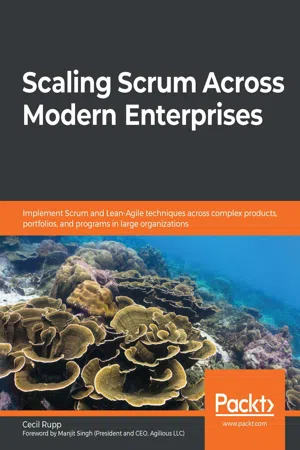
Scaling Scrum Across Modern Enterprises
Implement Scrum and Lean-Agile techniques across complex products, portfolios, and programs in large organizations
- 618 pages
- English
- ePUB (mobile friendly)
- Available on iOS & Android
Scaling Scrum Across Modern Enterprises
Implement Scrum and Lean-Agile techniques across complex products, portfolios, and programs in large organizations
About This Book
Establish business agility in your organization by applying industry-proven scaling strategies from popular Scrum frameworks such as Scrum of Scrums (SoS), Scrum@Scale, Nexus, Large-Scale Scrum (LeSS), Disciplined Agile, and SAFe
Key Features
- Learn how to be Agile at scale by implementing best practices
- Understand how Lean-Agile practices are incorporated in Disciplined Agile and the Scaled Agile Framework (SAFe)
- Customize Scrum and Lean-Agile practices to support portfolio and large product development needs
Book Description
Scaled Scrum and Lean-Agile practices provide essential strategies to address large and complex product development challenges not addressed in traditional Scrum. This Scrum/ Lean-Agile handbook provides a comprehensive review and analysis of industry-proven scaling strategies that enable business agility on an enterprise scale. Free of marketing hype or vendor bias, this book helps you decide which practices best fit your situation.
You'll start with an introduction to Scrum as a lightweight software development framework and then explore common approaches to scaling it for more complex development scenarios. The book will then guide you through systems theory, lean development, and the application of holistic thinking to more complex software and system development activities. Throughout, you'll learn how to support multiple teams working in collaboration to develop large and complex products and explore how to manage cross-team integration, dependency, and synchronization issues. Later, you'll learn how to improve enterprise operational efficiency across value creation and value delivery activities, before discovering how to align product portfolio investments with corporate strategies.
By the end of this Scrum book, you and your product teams will be able to get the most value out of Agile at scale, even in complex cyber-physical system development environments.
What you will learn
- Understand the limitations of traditional Scrum practices
- Explore the roles and responsibilities in a scaled Scrum and Lean-Agile development environment
- Tailor your Scrum approach to support portfolio and large product development needs
- Apply systems thinking to evaluate the impacts of changes in the interdependent parts of a larger development and delivery system
- Scale Scrum practices at both the program and portfolio levels of management
- Understand how DevOps, test automation, and CI/CD capabilities help in scaling Scrum practices
Who this book is for
Executives, product owners, Scrum masters, development team members, and other stakeholders who need to learn how to scale Agile to support large, complex projects and large enterprise portfolios and programs will find this book useful. A basic understanding of the values and principles of Agile and the Scrum-based framework for Agile development practices is required before you get started with this Agile Scrum book.
Frequently asked questions
Information
Section 1: Scaling Lightweight Scrum into a Heavyweight Contender
- Chapter 1, Origins of Agile and Lightweight Methodologies
- Chapter 2, Scrum Beyond Basics
- Chapter 3, The Scrum Approach
- Chapter 4, Systems Thinking
- Chapter 5, Lean Thinking
- Chapter 6, Lean Practices in Software Development
Chapter 1: TheOrigins of Agile and Lightweight Methodologies
- Lightweight software development methodologies
- Core agile implementation concepts
- The values and principles of agile
- Why engineers largely led this movement
Understanding what's wrong with the traditional model
- An authorized scope of work – no more, no less.
- Are temporary ventures with a specific start and an end date.
- May use borrowed (for example, from functional departments) or contracted resources over the project's life cycle.
- Have specific deliverable items (for example, products, services, or expected outcomes).
- The deliverables and the type of work are relatively unique.
- The uniqueness implies that some important information is not available at the start of the project, potentially impacting the project in some way when discovered.
- The uniqueness of the product and the work also implies that there is some level of risk in achieving the objectives on time, on budget, and with the allotted resources.
- The uniqueness of the deliverables implies the customers probably don't have a complete understanding of what they want or need – as it turns out, this is especially true when it comes to building software applications and systems.
- Processes provide a step-by-step set of instructions describing work within the phase. Phases typically have multiple processes, each describing a different type of work or approach to work.
- Activities (a.k.a. summary tasks) are artificial placeholders used to aggregate information about the completion of work in the underlying tasks. In other words, activities help roll up both the original estimates and the final measures of costs, time, and resources spent on the underlying work tasks.
- Tasks are the lowest practical level of describing work where a deliverable outcome is definable. Project managers often use the 8-80 rule to limit task durations to a range between 8 hours and 80 hours.

Table of contents
- Scaling Scrum Across Modern Enterprises
- Why subscribe?
- Preface
- Section 1: Scaling Lightweight Scrum into a Heavyweight Contender
- Chapter 1: TheOrigins of Agile and Lightweight Methodologies
- Chapter 2: Scrum Beyond Basics
- Chapter 3: The Scrum Approach
- Chapter 4: Systems Thinking
- Chapter 5: Lean Thinking
- Chapter 6: Lean Practices in Software Development
- Section 2: Comparative Review of Industry Scaled Agile Approaches
- Chapter 7: Scrum of Scrums
- Chapter 8: Scrum@Scale
- Chapter 9: The Nexus Framework
- Chapter 10: Large-Scale Scrum (LeSS)
- Chapter 11: Disciplined Agile
- Chapter 12: Essential Scaled Agile Framework® (SAFe®)
- Chapter 13: Full Scaled Agile Framework® (SAFe®)
- Section 3: Implementation Strategies
- Chapter 14: Contrasting Scrum/Lean-Agile Scaling Approaches
- Assessments
- Other Books You May Enjoy